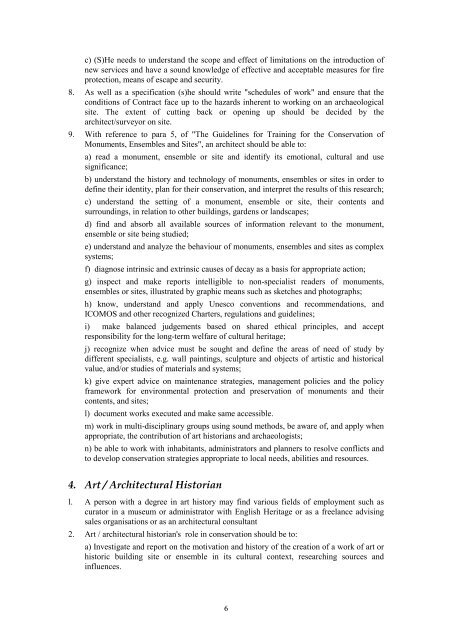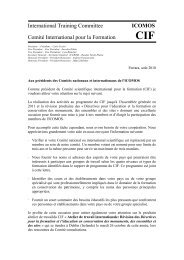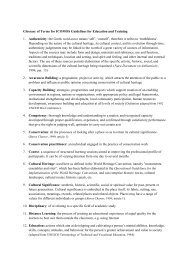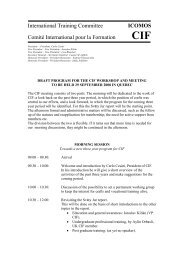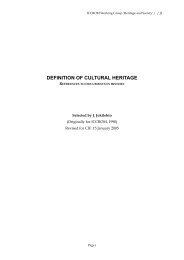COTAC Conference on Training in Architectural Conservation Multi ...
COTAC Conference on Training in Architectural Conservation Multi ...
COTAC Conference on Training in Architectural Conservation Multi ...
Create successful ePaper yourself
Turn your PDF publications into a flip-book with our unique Google optimized e-Paper software.
c) (S)He needs to understand the scope and effect of limitati<strong>on</strong>s <strong>on</strong> the <strong>in</strong>troducti<strong>on</strong> of<br />
new services and have a sound knowledge of effective and acceptable measures for fire<br />
protecti<strong>on</strong>, means of escape and security.<br />
8. As well as a specificati<strong>on</strong> (s)he should write "schedules of work" and ensure that the<br />
c<strong>on</strong>diti<strong>on</strong>s of C<strong>on</strong>tract face up to the hazards <strong>in</strong>herent to work<strong>in</strong>g <strong>on</strong> an archaeological<br />
site. The extent of cutt<strong>in</strong>g back or open<strong>in</strong>g up should be decided by the<br />
architect/surveyor <strong>on</strong> site.<br />
9. With reference to para 5, of "The Guidel<strong>in</strong>es for <strong>Tra<strong>in</strong><strong>in</strong>g</strong> for the C<strong>on</strong>servati<strong>on</strong> of<br />
M<strong>on</strong>uments, Ensembles and Sites", an architect should be able to:<br />
a) read a m<strong>on</strong>ument, ensemble or site and identify its emoti<strong>on</strong>al, cultural and use<br />
significance;<br />
b) understand the history and technology of m<strong>on</strong>uments, ensembles or sites <strong>in</strong> order to<br />
def<strong>in</strong>e their identity, plan for their c<strong>on</strong>servati<strong>on</strong>, and <strong>in</strong>terpret the results of this research;<br />
c) understand the sett<strong>in</strong>g of a m<strong>on</strong>ument, ensemble or site, their c<strong>on</strong>tents and<br />
surround<strong>in</strong>gs, <strong>in</strong> relati<strong>on</strong> to other build<strong>in</strong>gs, gardens or landscapes;<br />
d) f<strong>in</strong>d and absorb all available sources of <strong>in</strong>formati<strong>on</strong> relevant to the m<strong>on</strong>ument,<br />
ensemble or site be<strong>in</strong>g studied;<br />
e) understand and analyze the behaviour of m<strong>on</strong>uments, ensembles and sites as complex<br />
systems;<br />
f) diagnose <strong>in</strong>tr<strong>in</strong>sic and extr<strong>in</strong>sic causes of decay as a basis for appropriate acti<strong>on</strong>;<br />
g) <strong>in</strong>spect and make reports <strong>in</strong>telligible to n<strong>on</strong>-specialist readers of m<strong>on</strong>uments,<br />
ensembles or sites, illustrated by graphic means such as sketches and photographs;<br />
h) know, understand and apply Unesco c<strong>on</strong>venti<strong>on</strong>s and recommendati<strong>on</strong>s, and<br />
ICOMOS and other recognized Charters, regulati<strong>on</strong>s and guidel<strong>in</strong>es;<br />
i) make balanced judgements based <strong>on</strong> shared ethical pr<strong>in</strong>ciples, and accept<br />
resp<strong>on</strong>sibility for the l<strong>on</strong>g-term welfare of cultural heritage;<br />
j) recognize when advice must be sought and def<strong>in</strong>e the areas of need of study by<br />
different specialists, e.g. wall pa<strong>in</strong>t<strong>in</strong>gs, sculpture and objects of artistic and historical<br />
value, and/or studies of materials and systems;<br />
k) give expert advice <strong>on</strong> ma<strong>in</strong>tenance strategies, management policies and the policy<br />
framework for envir<strong>on</strong>mental protecti<strong>on</strong> and preservati<strong>on</strong> of m<strong>on</strong>uments and their<br />
c<strong>on</strong>tents, and sites;<br />
l) document works executed and make same accessible.<br />
m) work <strong>in</strong> multi-discipl<strong>in</strong>ary groups us<strong>in</strong>g sound methods, be aware of, and apply when<br />
appropriate, the c<strong>on</strong>tributi<strong>on</strong> of art historians and archaeologists;<br />
n) be able to work with <strong>in</strong>habitants, adm<strong>in</strong>istrators and planners to resolve c<strong>on</strong>flicts and<br />
to develop c<strong>on</strong>servati<strong>on</strong> strategies appropriate to local needs, abilities and resources.<br />
4. Art / <strong>Architectural</strong> Historian<br />
l. A pers<strong>on</strong> with a degree <strong>in</strong> art history may f<strong>in</strong>d various fields of employment such as<br />
curator <strong>in</strong> a museum or adm<strong>in</strong>istrator with English Heritage or as a freelance advis<strong>in</strong>g<br />
sales organisati<strong>on</strong>s or as an architectural c<strong>on</strong>sultant<br />
2. Art / architectural historian's role <strong>in</strong> c<strong>on</strong>servati<strong>on</strong> should be to:<br />
a) Investigate and report <strong>on</strong> the motivati<strong>on</strong> and history of the creati<strong>on</strong> of a work of art or<br />
historic build<strong>in</strong>g site or ensemble <strong>in</strong> its cultural c<strong>on</strong>text, research<strong>in</strong>g sources and<br />
<strong>in</strong>fluences.<br />
6


